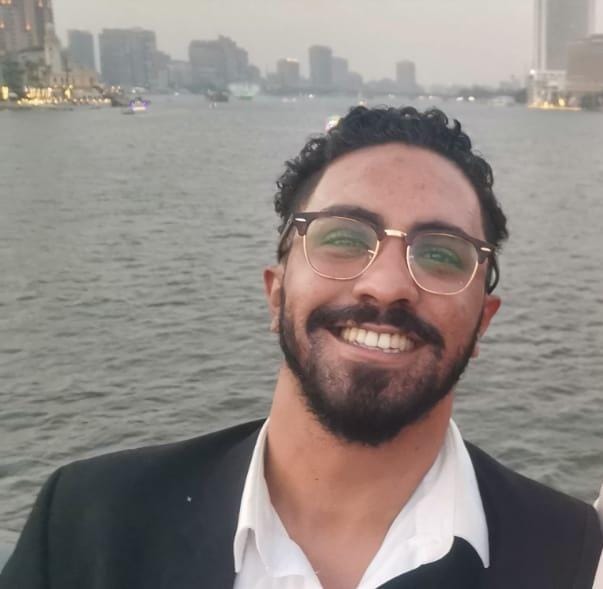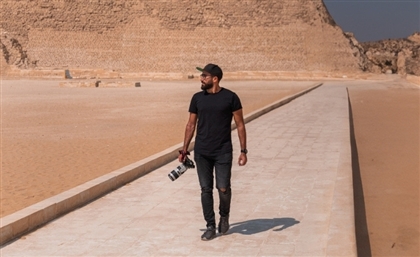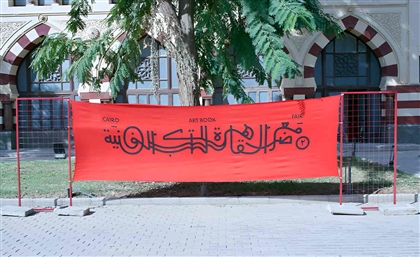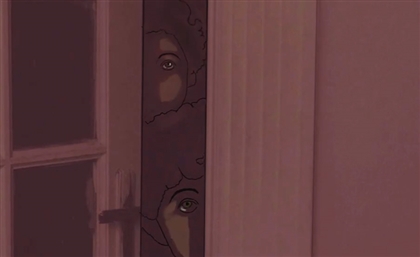Deena Fadel’s Exhibition Shines a Light on Healing & the Divine
Paintings and poems meditating on notions of the Divine and sanctity are on show at ‘Light/Nour: The Healing Space’.
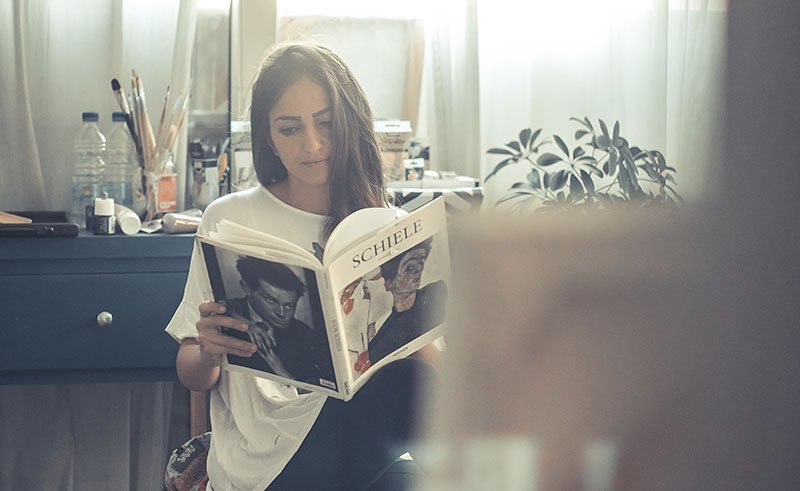
A ‘healing feeling’ was the first sensation that came to me as I entered Zamalek’s historic Picasso Gallery, where a new exhibition was taking place. Apart from the scents of Chanel wafting amongst the chic dresses and outfit, the opening night of ‘Light/Nour: The Healing Space’ by expressionist artist Deena Fadel exuded a sense of immense tranquillity and an immediate taste of the contemplative, accentuating the exhibition’s central theme of meditation, prayer and collective movement.
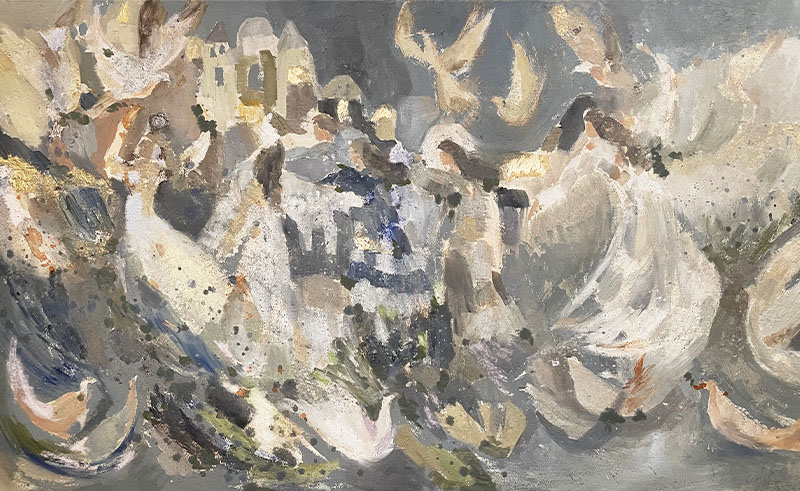 As other famed artists, patrons, relatives and friends traversed admiring the works on display and congratulating the artist on her opening night, I had the chance to sit with Fadel, and hear more about the inspiration behind her work and the core elements which guide her creative process.
As other famed artists, patrons, relatives and friends traversed admiring the works on display and congratulating the artist on her opening night, I had the chance to sit with Fadel, and hear more about the inspiration behind her work and the core elements which guide her creative process.
“I regard everything as an existent being. There is a prayer for a paintbrush, as there is a prayer for an experience. Everything, in my opinion, is an energy, an extant creation,” Fadel tells CairoScene. Perhaps a juxtaposition to the stereotype of the traditional Sufi painters - painting their miniatures in marble madrasahs clothed in the souf woollen dresses from which the word ‘Sufi’ derives - Fadel exudes a spiritual depth as equally as she does a comfortability with her cosmopolitan artistic nature.
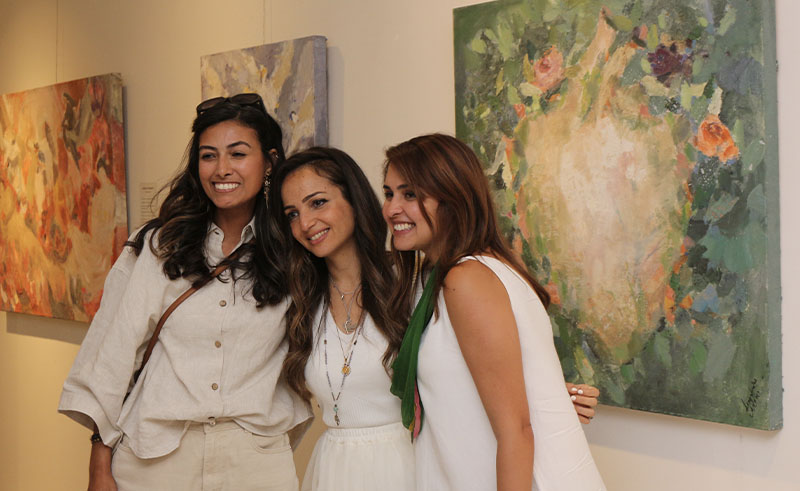 Shortlisted to be a part of a new project for the Louvre Abu Dhabi, Fadel was brought up in her youth between the UK and Qatar, and has participated in numerous exhibitions in Turkey, the United States, the United Kingdom, Qatar and Egypt. Her oeuvre has spanned numerous subjects, focusing on themes of chaos, of the vicissitudes of personal progress, and of the universal notion of love amongst others. Fadel’s artistic expressionism employs numerous mediums including writings, paintings and dance in furthering her raison d’etre of using her creativity as an extension of her spiritualism.
Shortlisted to be a part of a new project for the Louvre Abu Dhabi, Fadel was brought up in her youth between the UK and Qatar, and has participated in numerous exhibitions in Turkey, the United States, the United Kingdom, Qatar and Egypt. Her oeuvre has spanned numerous subjects, focusing on themes of chaos, of the vicissitudes of personal progress, and of the universal notion of love amongst others. Fadel’s artistic expressionism employs numerous mediums including writings, paintings and dance in furthering her raison d’etre of using her creativity as an extension of her spiritualism.
This exhibition is, in essence, an extension of the artist’s deeply personal connection to her philosophy of the necessity of sharing with, and connecting others to, her expressions of her discourse with the Sacred. “To me, Divine Light is not something to be guarded about,” Fadel says. “It is crucial that when one brushes with an energy that one considers to be sacred, that it be allowed to flow, and to move, and to be shared with others. It should not be something enclosed within oneself. In fact, it is a suffering to keep the light within oneself from people.”
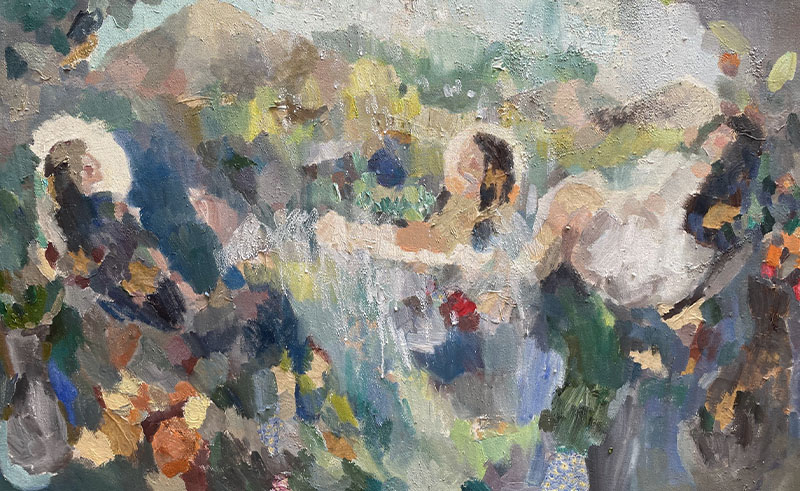 I indulged in the exhibition’s welcoming instruction which reads, “In this space I’d like to invite you to pray, meditate, walk, play, dance and bathe your soul in music. Let Divine Light shine through every part of you. Feel it pour into your body, heart and soul.” This invitation from Fadel, to explore her artworks not through the lens of commercialism, nor of art journalist, nor of haute connoisseur, but rather of a human being experiencing the dialogue of another human being’s expressions of the inner workings of the soul through paintings and writings, allows one to properly submit to the curated experience.
I indulged in the exhibition’s welcoming instruction which reads, “In this space I’d like to invite you to pray, meditate, walk, play, dance and bathe your soul in music. Let Divine Light shine through every part of you. Feel it pour into your body, heart and soul.” This invitation from Fadel, to explore her artworks not through the lens of commercialism, nor of art journalist, nor of haute connoisseur, but rather of a human being experiencing the dialogue of another human being’s expressions of the inner workings of the soul through paintings and writings, allows one to properly submit to the curated experience.
Amidst paintings, subtly reflecting the movement of bodies and the interconnectedness of beings, lay scented candles and literary meditations of the sacred, including some poems by Fadel herself, Quranic verses, and poems by the Sufi mystic Rumi. Certain paintings clearly reference the Sufi practice of the Mawlawy order of sama, the circular whirling meditative dance. Fadel, herself a student of dance movement therapy, is an advocate of collective movement as a meditative practice. “Movement, and collective movement especially, is a central way of sharing this notion of Divine Light with other human beings. Divine Light should not be stagnant and stored, it is vital to get up, to hold the hands of other humans, to move, to dance, and share it with the people.” The form of human bodies moving in tandem is thus a core picture in many of the exhibition’s artworks.
 The hues of Nile-papyrus greens and blues reminiscent of clear Spring mornings, and the bright yellows and deep oranges, all reflect the artist’s obsession with the sacred’s connection to nature, as well as to the centrality of the sun in Egypt’s natural landscape and its ancient and modern-day spiritual practices. “There was a moment where I had taken a vacation in Fayoum, during a turbulent period of my life where I had not had much interaction with nature, when suddenly, the vivid textures and hues of the Egyptian countryside nature stood out to me, and brought me peace,” she shares. “The colour of the flowers change, based on whether the sun is in its morning position or whether it is setting. Since then, the colours of nature have been very present in my works.”
The hues of Nile-papyrus greens and blues reminiscent of clear Spring mornings, and the bright yellows and deep oranges, all reflect the artist’s obsession with the sacred’s connection to nature, as well as to the centrality of the sun in Egypt’s natural landscape and its ancient and modern-day spiritual practices. “There was a moment where I had taken a vacation in Fayoum, during a turbulent period of my life where I had not had much interaction with nature, when suddenly, the vivid textures and hues of the Egyptian countryside nature stood out to me, and brought me peace,” she shares. “The colour of the flowers change, based on whether the sun is in its morning position or whether it is setting. Since then, the colours of nature have been very present in my works.”
When asked about the references to the sun in her works through her use of yellows, golds and oranges, Fadel explained her fascination with the ancient Egyptian notion of the sun as a healer and a restorer. “When one studies ancient Egyptian wisdom, one finds that, when unwell, the hakim (wise one) would be summoned. When he would arrive to treat the patient he would not only prescribe medicine, but also affirmations, prayers, crystals. If he were called for a patient who was unwell mentally and who was unable to move because of mental strain, he would prescribe sunlight at specific parts of the day to empower the body as well as the spirit, illustrating the healing nature of the sun.”
 I left the exhibition having experienced that healing energy that it had been curated to express. Fadel’s words lingered on in my mind for a while after, that to create is to engage in the spiritual. “To create authentically,” she says, “one must allow one’s ego to be tamed, so as not to interfere in the spiritual process.”
I left the exhibition having experienced that healing energy that it had been curated to express. Fadel’s words lingered on in my mind for a while after, that to create is to engage in the spiritual. “To create authentically,” she says, “one must allow one’s ego to be tamed, so as not to interfere in the spiritual process.”
‘Light/Nour: The Healing Space’ is on show at the Picasso Gallery on Zamalek’s Hassan Assem Street until May 30th.
- Previous Article Italian-Palestinian Duo No Input Debuts Eponymous Electro EP
- Next Article Travel Across History on Egypt's Most Iconic Bridges
Trending This Week
-
Dec 12, 2025







